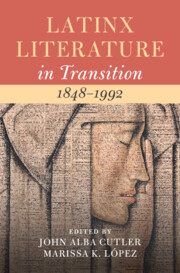Book contents
- Latinx Literature in Transition, 1848–1992
- Latinx literature in transition
- Latinx Literature in Transition, 1848–1992
- Copyright page
- Dedication
- Contents
- Figures
- Contributors
- Acknowledgments
- Introduction
- Part I Space
- Part II Being
- Part III Time
- Chapter 9 Death at and Afterlives of the Silver Dollar Café in Chicanx Cultural Production
- Chapter 10 Passing Time
- Chapter 11 Romancing Latinidad
- Chapter 12 Singing Apocalypse
- Part IV Form
- Part V Labor
- Bibliography
- Index
- References
Chapter 11 - Romancing Latinidad
Race, Resistance, and Latinx Theater History
from Part III - Time
Published online by Cambridge University Press: 10 April 2025
- Latinx Literature in Transition, 1848–1992
- Latinx literature in transition
- Latinx Literature in Transition, 1848–1992
- Copyright page
- Dedication
- Contents
- Figures
- Contributors
- Acknowledgments
- Introduction
- Part I Space
- Part II Being
- Part III Time
- Chapter 9 Death at and Afterlives of the Silver Dollar Café in Chicanx Cultural Production
- Chapter 10 Passing Time
- Chapter 11 Romancing Latinidad
- Chapter 12 Singing Apocalypse
- Part IV Form
- Part V Labor
- Bibliography
- Index
- References
Summary
This chapter examines the implications of mapping Latinx theater history through a singular narrative of race and cultural resistance. Scholars have written the history of Latinx theater as the story of minoritarian struggles for representation against the dominant white gaze since the 1960s. I assess how the narrative of overcoming racial oppression has taken a decidedly romantic form since it tells the story of how Latinx communities move from oppression toward an emancipatory future, and how, in turn, this romance’s linear temporal plot defines Latinidad as brown and as antithetical to whiteness. The “romance of Latinidad,” I argue, has served generations of Latinxs artists to craft an aesthetic and a cultural politics of resistance. However, the story of brown resistance consolidates a post-1960s brown/white racial binary that erases non-brown Latinxs from Latinx theater history. After tracing the generations of artists included in the resistance narrative, the chapter turns to Latinidad’s pre-1960s past and discusses the biography and racial ideologies of Josefina Niggli (1910–83), the Mexican American playwright whose whiteness and folkloric representations of Mexicans trouble the romance of brown resistance. Indeed, the analysis seeks to account for Latinidad’s antiracist possibilities by reckoning with Latinx theater’s collusions with racism.
Keywords
- Type
- Chapter
- Information
- Latinx Literature in Transition, 1848–1992 , pp. 195 - 209Publisher: Cambridge University PressPrint publication year: 2025

